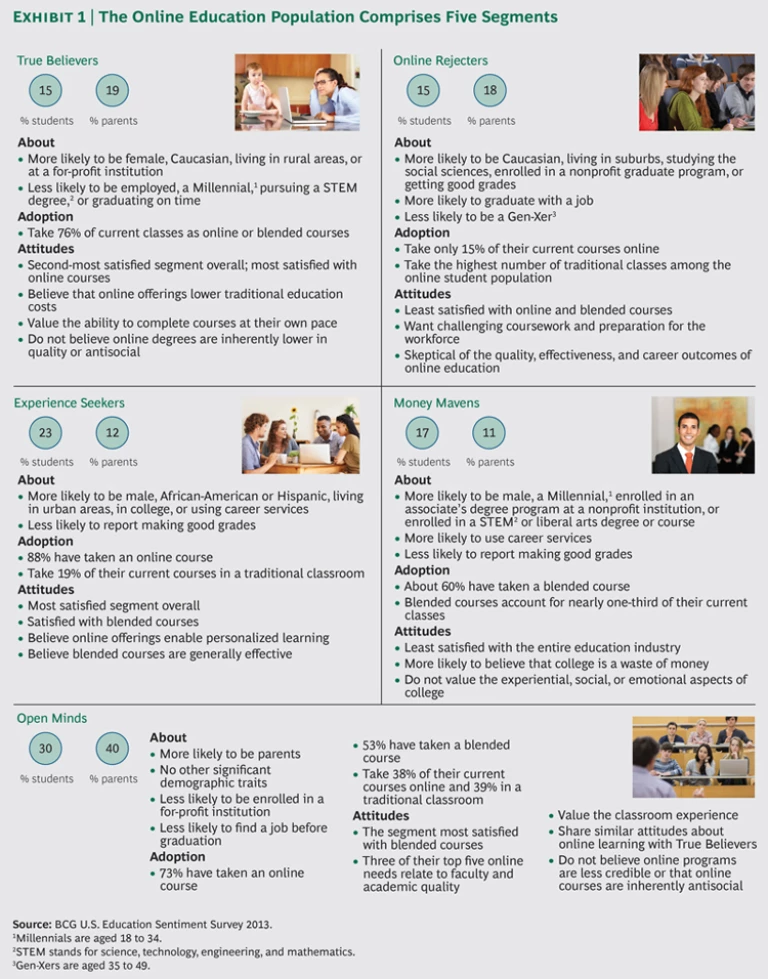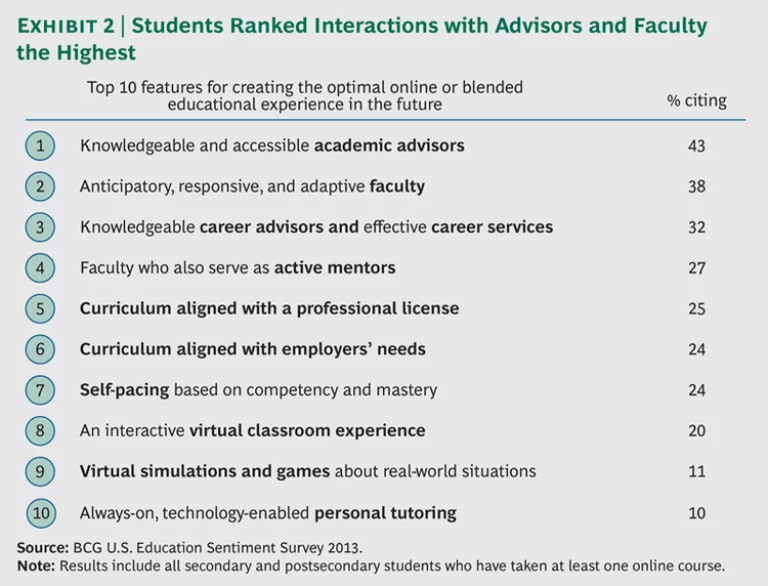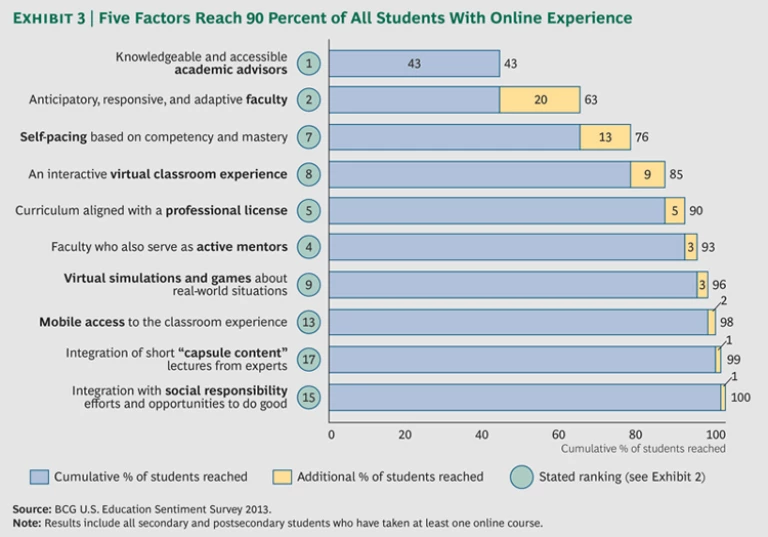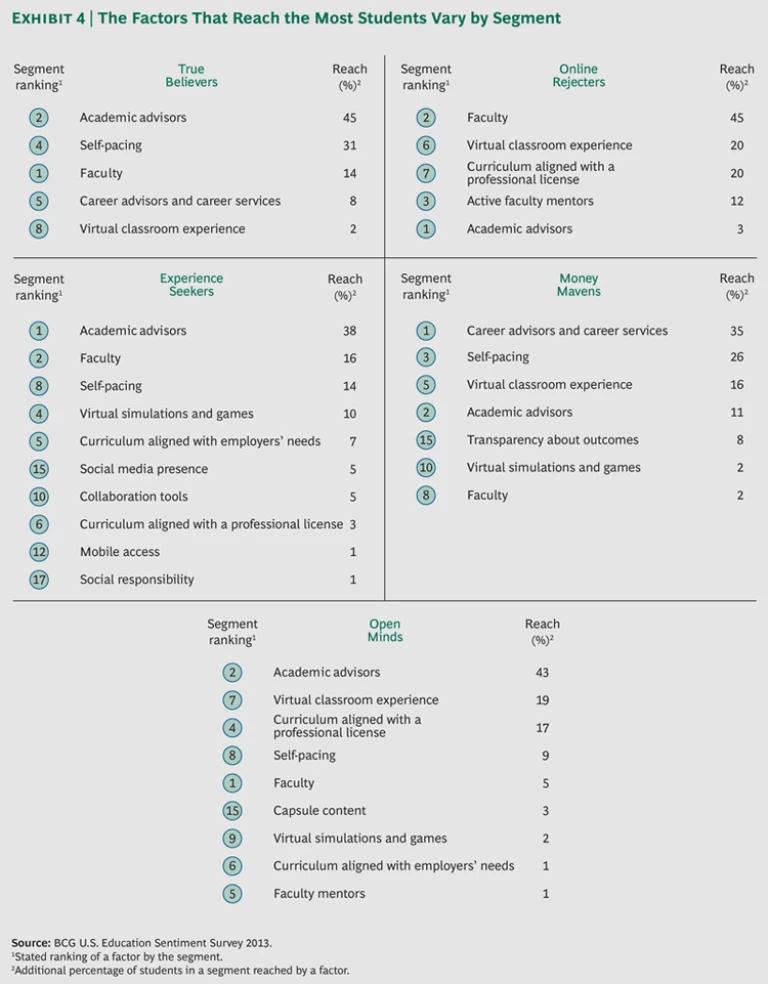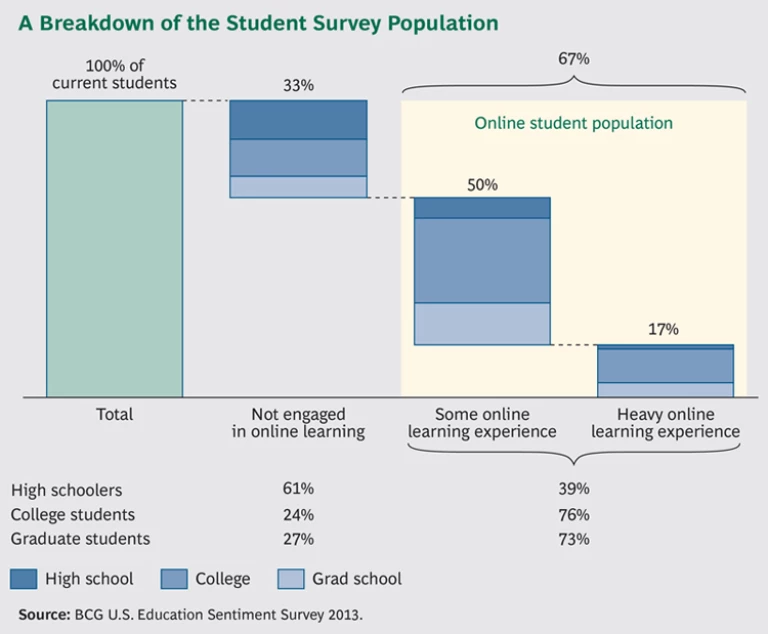In the not-so-distant past, the relatively small number of people who took online classes in the U.S. saw at-your-own-pace learning as a good alternative to traditional, in-person classes. Adults with careers and children often took advantage of online classes and degrees due to the convenience the classes afforded them to learn anywhere, anytime. In the minds of many people, online degree programs were largely associated with for-profit institutions, even though many nonprofit institutions offered individual online courses.
Today, what was once a niche educational medium has become part of the mainstream. For instance, 60 percent of post secondary institutions report
In addition, online education is associated with a wide range of educational institutions, including some of the most prestigious nonprofit universities in the country. What had at one point involved a trade-off of quality for convenience has begun to achieve a level of quality in terms of reputation and teaching that requires fewer compromises.
Now, a BCG survey of more than 2,500 students and 675 parents in the U.S. con-firms these trends and adds rich, new insights—for example, exploring the student experience with blended courses (which combine online and in-class instruction) and uncovering detailed student needs and segments. (The survey is part of BCG’s larger Global Consumer Sentiment series. See The Resilient Consumer: Where to Find Growth amid the Gloom in Developed Economies, BCG Focus, October 2013.)
Consistent with the estimates above, the results of the BCG U.S. Education Sentiment Survey indicate that the proportion of students currently taking at least one online course stands at 30 percent of postsecondary students. We further estimate from the survey results that 16 percent of postsecondary students are currently learning primarily through online courses.
Furthermore, BCG’s research has identified universal attitudes about online education among students and parents. For example, our survey shows that students across all demographics and backgrounds now want to mix online only, blended, and traditional classroom courses to create a learning experience that combines virtual and traditional settings. In fact, our survey suggests that more than 25 percent of students are currently taking at least one blended course. We have also found that students desire a much greater level of interactivity than current learning environments often provide.
However, our research has also found that different groups of students have widely varying expectations of—and needs for—their future learning experience. These similarities and differences point to important lessons for leaders anticipating and shaping the future of online education. Institutions that fail to prepare for these shifts and respond to the dramatically increased competition among online offerings risk losing relevance and overall market share. Those that adapt will discover huge untapped opportunities for growth, new platforms for innovation, and the potential to transform how future generations of students learn.
What Students and Parents Want
As a consequence of the increasing spread of online education, institutions are finding that the needs of the current mix of students differ from those of the past. Those needs are being transformed by broader generational, digital, and marketing trends. Four universal attitudes stand out across all the respondents to the BCG U.S. Education Sentiment Survey—regardless of their generation, type of university, life stage as a student or parent, or other characteristics.
Attitudes toward online courses are surprisingly positive. However one measures online learning—whether as a self-contained course or as a component of a traditional class—experience with online education is widespread. Our survey found that 67 percent of secondary and postsecondary students report experiencing online education to some degree.
We define those with online education experience as students who have taken an online or blended course and as parents whose children have taken an online course. (By definition, this percentage exceeds the 30 percent of students who we found are currently taking at least one online course, referenced above.) Unless otherwise noted, this report focuses on the majority of secondary and postsecondary students and parents who have experienced online education. (For more details about the methodology used in the BCG U.S. Education Sentiment Survey, see the Appendix at the end of this report.)
College and graduate students are almost twice as likely as high school students to have experienced online education. Although 76 percent of college students and 73 percent of graduate students reported experience with an online course, only 39 percent of high school students had experienced online education. Yet we expect high school exposure will increase as the digital infrastructure and the adoption of online courses in K–12 education approach current levels in higher education.
Students are quite open to online and blended courses and, to a lesser extent, hybrid degrees that mix online and in-classroom courses. More than half of students who have taken an online or blended course said they found online courses are as effective as on-campus classes. Sixty-two percent said they believe that the traditional classroom experience benefits from online instruction, and 63 percent agreed that online courses and degrees are gaining in importance as a part of the criteria for choosing an educational institution.
Given the recent controversies in the media and the attention paid by federal and state governments to online education, particularly at for-profit institutions, we expected to find more negative attitudes about online education in our survey, as well as lower levels of reported experience with and adoption of online education.
But most of the five segments our research identified held generally positive attitudes toward online education. (We explore the segments and their varying attitudes in the next section of this report.) Many students see the benefits of online education to enable independent learning, improve access to education (as for homeschooled children), accelerate the completion of a degree program, and help address significant competing or challenging priorities and issues (including the need to work full or part time).
Certainly, some degree of positivity was expected, considering the younger generation’s digital-native status as early and heavy users of multiple forms of technology and devices. That their parents also have a positive view of online education surprised us, however. We found that many parents now advise their children to pursue degrees with at least some online component. As with other digital, media, and marketing trends, Millennial students (aged 18 to 34)—like Millennial consumers more generally—serve as leading indicators of accelerating behaviors and attitudes among the older Gen-Xers and baby boomers.
Skepticism remains about online-only degree programs. Students and parents are open to the idea of taking courses online. But parents in particular—who often pay most of the tuition—are not sold on degrees earned entirely online. Parents in our survey were 13 percentage points more likely to withhold financial support for a child pursuing an online degree than for one pursuing a traditional or a hybrid degree. Parents in the top 5 percent income bracket and fathers were the most likely to withhold support for an online degree.
Almost 60 percent of respondents reported that the biggest barrier to the acceptance of online-only degree programs concerned their reputations among students (58 percent) and general faculty (57 percent). The third most cited barrier was the lack of regulation or accreditation for online degrees and courses. The fourth most cited was the perceived quality of online teachers or faculty. Interestingly, a reputation for low employment outcomes was one of the least cited barriers to the acceptance of online degrees.
Blended courses have surpassed traditional courses in popularity. Almost 60 percent of respondents who have taken an online course said they believe blended courses mixing online and in-person instruction can improve the quality of education; only 50 percent of respondents said the same for fully online instruction. That view is consistent with the speed with which the field is moving toward blended courses and hybrid degrees—and the enhanced outcomes and experiences they can generate.
Students are more likely than their parents—50 percent versus 44 percent—to think that blended courses deliver better outcomes in education than traditional instruction does. But parents are warming up to the idea of blended courses, with levels of acceptance that can exceed that of traditional education—if the blended courses are structured to supplement traditional courses rather than replace the instruction. For instance, parents preferred “mostly traditional with some online elements” (which 39 percent of parents accepted) over a “traditional” degree (24 percent) and a “50-50 hybrid” degree (20 percent).
Students are demanding much greater interactivity and connectivity. Most online-education institutions have historically focused on asynchronous experiences in which students learn at their own pace without the constraints of time and place. But students are demanding much more: Fifty-four percent of students said they see the online classroom experience as a barrier.
Across all demographics and backgrounds, students overwhelmingly respond to an online environment that provides significant connections both in person as well as over multiple devices at the same time. Broader Millennial trends such as the need to frequently connect online and offline, the shift in the definition of an expert from only those who have professional or academic credentials to also include peers or close friends, and this generation’s overall tech savviness, help to explain these evolving educational behaviors and preferences. (See The Millennial Consumer: Debunking Stereotypes, BCG Focus, April 2012.)
For example, across all demographics and backgrounds, the students we surveyed wanted greater real-time contact with faculty, advisors, and other students. Many students expressed a strong desire for virtual classrooms that allow engagement beyond video- or text-based lectures and encourage interactivity among faculty and students. Currently, such interactivity is happening primarily at a basic level, offering engagement without creating true interactivity. Innovations in this area might not have been critical to previous waves of online students, but they matter significantly today, especially when it comes to expanding the relevance of online classrooms for new types of students.
The Five Faces of Online Education
Despite shared attitudes and preferences in general, students and parents are by no means homogeneous. We have identified five distinct segments within the online education population: True Believers, Online Rejecters, Experience Seekers, Money Mavens, and Open Minds. (For snapshots of these five segments, see Exhibit 1.) Each displays important differences in educational experiences, age, behaviors, priorities, methods of engagement, and—to a lesser extent—demographics.
As institutional leaders think about which types of students they want to attract and how they will market to and serve those students, it will be important to focus in a more nuanced way on the increasing diversity of expectations for the online experience. Reaching emerging growth segments of the population will require innovation in many areas, such as the classroom experience, course duration and start date, support services, faculty, outcomes, institutional transparency, and marketing.
At the extremes, the expectations are bookended by two early-mover segments—representing a total of more than 30 percent of the surveyed student population—with radically different views of online education.
True Believers. These students take the majority or all of their classes online. They are vocal advocates for the benefits of the asynchronous, learn-at-your-own-pace convenience of conventionally delivered online education. This segment sees online as a great alternative to traditional, in-person education, rather than as an integral part of the full menu of educational offerings. The segment is the most open to online education and sees very few inherent barriers to future adoption. This population will be familiar to institutions as the original group that online education grew to serve.
Online Rejecters. These students have tried online courses, but they have decided not to take more in the future. Members of this group consider the quality and reputation of online programs to be a barrier to taking additional online or blended courses, and they tend to be skeptical about the outcomes and quality of the online experience. Parents in this segment are particularly hesitant to recommend online education for their children due to what they perceive as its reputation for generating poor employment prospects.
The remaining three segments, comprising almost 70 percent of the surveyed education population with online experience, are generally positive about online education, but their attitudes and behaviors diverge in important ways. These segments—taken together with the group of people still inexperienced with an online or blended course—represent the vast majority of the population institutions will serve in the future.
Experience Seekers. These students place a unique emphasis on the experiential, social, and emotional benefits of education. They share traditional beliefs about college, such as that college it the best place to make lifelong friends and that college is critical to emotional and character development. Perhaps surprisingly, it does not matter greatly to them which form their education takes, so long as they achieve their goal of a degree for personal and social advancement.
Money Mavens. Members of this segment are motivated primarily by the financial outcomes of an education. They want to achieve an acceptable return on their investment, get a better job, and make more money. They view an education much more as a transaction than as an experience.
Open Minds. Members of this segment will become True Believers if the online experience meets their high standards and offers benefits beyond those of traditional classrooms, such as greater interactivity with professors and peers. This group represents the largest potential for growth in online education over the near term. As its members increasingly get what they want from online and blended classrooms, they will become the primary source of supply for existing and emerging segments of online enthusiasts.
Implications for Institutions
Educational leaders and institutions would be wise to pay careful attention to these segments and the shifts in demand they represent. Traditional models will not reach most of the population in the future. Even existing online models—with their emphasis on mostly static, learn-at-your own-pace experiences and undifferentiated teaching—will not be sufficient unto themselves. And what will work in the future will not be the same for every institutional type or individual institution. Institutions that thrive will have both better insights about students, as well as better strategies and responses tailored to those insights.
Consider, for example, the features that students stated explicitly were the most important in creating the optimal online or blended educational experience in the future. (See Exhibit 2.) When forced to rank future features that would most improve the educational experience, the students we surveyed prioritized knowledgeable and accessible academic advisors, responsive and adaptive faculty, knowledgeable career advisors and effective career services, and faculty who also serve as career mentors.
A mass-market approach would focus investments in delivery and marketing toward the highest priority of these explicitly stated needs. Not surprisingly, traditional nonprofits have invested heavily in bolstering faculty, as well as in marketing the quality of their institutions, faculty, and degrees. For-profits and community colleges, on the other hand, have historically suffered from a gap in their perceived quality. While these kinds of investments in quality are indeed important at present, they are no longer sufficient for the future needs of students and parents. The finding that students rank academic advising ahead of faculty and teaching quality for the improved online-education experience of the future makes this clear. It demonstrates the growing importance of advising, a factor that is also proven to drive higher retention and completion rates, particularly in an online environment that requires significant student motivation.
Institutions need to consider two student-centric concepts that go a step beyond understanding explicitly stated needs. For one, they should evaluate the ability of strategies and investments to use a minimum number of features to appeal to, or “reach,” the maximum number of students and potential students. In other words, certain factors are related in terms of appeal, making it hard to tell which factors are helping reach new people and which are merely appealing to the same people. Prioritizing or more heavily investing in some of these related features might improve existing student satisfaction but might not increase the number of students who would consider applying to a school. By contrast, an analysis of so-called unique or unduplicated reach measures the additional students that each factor appeals to. Effectively, the analysis identifies the priority factors that are likely to influence student consideration of a school.
Student consideration is important to schools looking to grow, reposition their brands, or improve student quality. In addition, student consideration is vital to all schools aiming to maintain or improve the number and quality of applicants, particularly as the student population evolves. Institutions must balance the factors that improve existing student satisfaction with the factors that appeal to new, attractive, or evolving student populations. Understanding student needs in multiple ways allows institutions to direct their limited investments toward features that have the greatest impact on meeting their objectives, enabling schools to maximize their resources.
To briefly illustrate the concept of unique or unduplicated reach, consider the explicitly stated needs of all students listed in Exhibit 2. When viewed as part of an objective to appeal to the broadest student population with the fewest features, factors such as completing courses at one’s own pace or enjoying an interactive virtual classroom experience prove popular with more total students than the explicitly stated factors of having faculty mentors and a curriculum focused on obtaining a professional license. (See Exhibit 3.)
In addition to looking at unduplicated reach, institutions should also tailor their approaches to each student segment. We have found that the individual factors that increase consideration among members of a segment, and therefore that add new students, vary considerably. (See Exhibit 4.) Amid the reality of constrained re-sources, leaders must meet unique student needs and generate insights into which factors meaningfully increase reach among high-priority groups. Such tactics allow institutions to do more with less as they target individual student segments, deliver greater student satisfaction, and improve student outcomes. In addition, a segment-ed approach highlights ways that institutions may evolve in order to break out of the confines of historical perceptions and to attract entirely new types of students.
Of course, different types of institutions vary in their inherent credibility with each segment. The same is true at the individual institutional level. The insights that fol-low are not intended to replace the need for institutions to understand and respond to how students specifically view them and their reputations. Rather, we share the following general strategies to help a range of institutions develop more sophisticated ways to target programs to and expand their reach within the right segments.
True Believers
The optimal online or blended educational experience for this segment delivers on top needs such as knowledgeable academic advisors and responsive faculty—factors that also appeal to other segments. Our analysis of unduplicated reach, however, reveals that institutions can add new members of this segment by making investments and innovations in both self-paced courses and career advising and services. This segment is also potentially reached by gaining greater recognition from other institutions of transfer credits for online courses, by offering access to exclusive or unique courses and instructors, by providing students the ability to complete a degree faster, and by increasing opportunities for personalized learning.
Institutions that currently fare best with this segment are for-profits and nonprofits with associate’s degree programs. To best tap into the segment’s attitudes, marketing messages should stress convenience, flexibility, self-pacing, a shorter time to complete a degree, independent work and study options, increased personalization, and lower cost.
In the near and medium term, we expect this segment to grow as a percentage of the overall online-education population, to broaden beyond its for-profit institutional base, and to evolve in its needs. Growth among this group will come from the Open Minds segment, as well as from students who currently lack online course experience.
Online Rejecters
This segment places a higher priority on faculty than other segments: Three of the five factors that appeal to students in this segment are related to faculty. Other valuable features to Online Rejecters are virtual classrooms that offer significantly more interaction with peers and professors, as well as a curriculum aligned with a professional license.
Nonprofit institutions and postgraduate programs with predominantly traditional, on-campus classes currently have the best chance with this group, given that this segment has tried and, for now, has rejected online offerings. Traditional messages about high-quality faculty; the exclusiveness of admissions; the challenge of coursework; and the social, emotional, and experiential benefits of campus life remain most relevant. Given the attitudes of these students and parents, changing the minds of Online Rejecters about online degrees and courses, or even the benefits of technology to the campus experience, would be a costly endeavor, unless institutions can achieve significant innovations in the fully online experience.
This group is the second most dissatisfied segment—not only with online courses, but also, interestingly, with blended classes, the cost of education, educational and career outcomes, and the return on their educational investment. Members of this segment need to be convinced of the evidence, such as from the
We expect this segment to stay the same size or to contract as a percentage of the overall online-education population.
Experience Seekers
When it comes to an optimal online and blended educational experience, this segment prioritizes a much longer list of features than other groups. Gamelike learning and simulations, employer-aligned curriculum, a social media presence, and online collaboration tools all disproportionately appeal to students in this segment. However, members of this segment also share priorities with other types of students and parents, increasing the likelihood that investments in such shared needs will bring along a wider range of students. For example, self-paced learning significantly appeals to Experience Seekers, and that interest is shared with True Believers, Money Mavens, and, to a lesser extent, Open Minds.
This segment’s unique needs also signal potential emerging expectations among future students, including mobile access to online education and a tight integration of courses with social responsibility efforts and opportunities to do good. These students and parents are extremely open to—but relatively less satisfied with—blended courses, signaling another potential opportunity to reach members of the group with an enhanced educational experience.
Counterintuitively, this segment is most like Online Rejecters in seeing multiple barriers to—and thus opportunities for—the future acceptance and adoption of online and blended education. As with Online Rejecters, this segment sees barriers in other faculty members’ acceptance of online education, faculty and teacher quality, evidence of outcomes, the online classroom experience, and the reputation of online education. Unlike Online Rejecters, this segment sees multiple technical barriers, too.
Institutions with the best potential to reach this segment in the near term include both for-profits and nonprofits that offer predominantly bachelor’s degrees. Marketing messages should emphasize the social, emotional, and experiential benefits of the institution and of online and hybrid programs; innovative interactive features; and employer-aligned curriculum and work experiences.
We expect this segment to grow as a percentage of the total population. It will gain members from the Open Minds segment, as well as from students who currently lack online course experience.
Money Mavens
For this segment, career advising and services and self-paced learning are the defining factors in the optimal online and blended education experience. Emerging needs that may better position institutions with this and other segments include transparency about outcomes and gamelike learning and simulations.
Money Mavens have a higher than average degree of awareness about alternative models such as “massive open online courses” (MOOCs) capable of reaching an unlimited number of students and so-called a la carte education, which allows students to assemble a degree from several sources. Other segments do not seem to be paying much attention to these emerging models—at least not yet. The tactics to watch in terms of appeal to this segment are virtual group projects, badges and certificates, and e-portfolios.
For the most part, people in this segment see low barriers to the future adoption of online and blended courses. Among the segments, members of this group are least likely to see as barriers the following: insufficient or inadequate offerings, research on outcomes, teacher and faculty acceptance, and the reputation of online education.
Institutions that fare best with this segment today are nonprofits with associate’s degree programs. Marketing messages about career services, proven outcomes, self-pacing, and program costs are likely to disproportionately appeal to this group.
We expect this segment to grow as a percentage of the population. New members will come from the Open Minds segment, as well as from students who currently lack online course experience.
Open Minds
This is an evolving segment. Attitudes about the benefits of online and blended education are most akin to those of True Believers—although members of the group hold these views with less intensity. But their academic and quality needs are most like those of Online Rejecters.
Open Minds generally see more barriers to the adoption of online and blended degrees and courses than True Believers. In fact, they resemble Online Rejectors in their perception of barriers related to research on proven outcomes from online and blended education, the online classroom experience, and the quality of faculty and teachers for online programs. But they differ from Online Rejecters in their belief that online degrees and courses are not inherently antisocial.
A distinguishing need of the segment is an interactive virtual classroom experience, a priority most segments share to some degree. Investment in this area versus other student priorities will likely also attract many types of students. These students would like to see, in order of priority, features such as virtual chalkboards; the ability to search class textbooks, videos, or resources online for topics or discussion threads; the ability to post questions and answers or to rate classmates’ responses online; the ability to meet professors, teaching assistants, or student groups online via chat or video; and mobile access to the online classroom and course materials. Technology-enabled needs that are emerging include the ability to see, hear, and interact with faculty and classmates using real-time virtual classrooms and collaboration tools.
Institutions that currently fare the best with this segment are nonprofits with online and blended educational offerings. Marketing messages that should uniquely reach this segment include those about curriculum pragmatically aligned with obtaining a professional license, about blended courses and the technology-enabled classroom experience, and about the institution’s investment in technologies that improve the student experience.
Furthermore, Open Minds are the most satisfied with blended courses, so marketing messages that appeal to True Believers in this area should also appeal to this segment. Similarly, marketing messages that appeal to Online Rejecters—such as those about teaching faculty; the quality of the education; and the social, emotional, and experiential benefits of college life—should also attract this group.
As the needs of Open Minds are increasingly met by the online and blended classroom experience, they will become the main well from which other existing and emerging segments of online enthusiasts will draw.
Today’s nascent attitudes and behaviors will be tomorrow’s opportunities. In the future, growth will also come from altogether different places than it has in the past.
Successful institutions will understand how groups of students differ; which segments to target for growth and innovation; and how to prioritize investments, operations, and marketing messages to meet more needs with fewer resources. They will adapt the learning experience of online and blended classes and degrees to the unique ways that students expect to learn in the future. Those that get ahead of these trends will be in the best position to thrive.
Appendix: Survey Methodology
To gain an in-depth understanding of current attitudes toward online education in the U.S., BCG surveyed more than 2,500 students and 675 parents in the U.S. (See the exhibit, “A Breakdown of the Student Survey Population.”) All respondents were at least minimally experienced with online education: Students had taken at least one course online, and parents had a child who had taken at least one course online. Online courses were defined as online or blended classes, which include both online and traditional classroom instruction.
We included students currently enrolled in high school (grades 9–12), college (two-year and four-year degree programs), and graduate school, as well as those who graduated within the past 18 months. Parents surveyed had at least one child currently enrolled in high school or college. The sample in the BCG U.S. Education Sentiment Survey matched the overall U.S. population engaged in secondary and post-secondary education in terms of gender, race, ethnicity, household income, and enrollment in for-profit and nonprofit institutions.
Acknowledgments
This report would not have been possible without the efforts of our BCG Millennial educational panel: EJ Brizzolara, Claire Cole, Chris Harlan, Tony Illig, Megha Kansra, Hari Sathyendran, and especially Katie Mullen and Jennifer Vigness. The authors would also like to thank the following members of BCG’s education team: Matt Claise, Peter Davis, Rebecca Ginns, Tyce Henry, Elizabeth Kaufman, Tejus Kothari, Lane McBride, J. Puckett, Nneka Rimmer, Jeff Shaddix, Jo Wilson, and especially Rebecca Solow. Furthermore, the authors wish to thank Rich Hutchinson, Catherine Roche, and Kate Manfred for their invaluable support. The authors are grateful to Carmen Roche and Patrick R. Riccards for their guidance on marketing and interaction with the media; Mickey Butts for his invaluable writing leadership; and Katherine Andrews, Gary Callahan, Kim Friedman, Abby Garland, Mary DeVience, and Sara Strassenreiter for their editorial, design, and production assistance.
